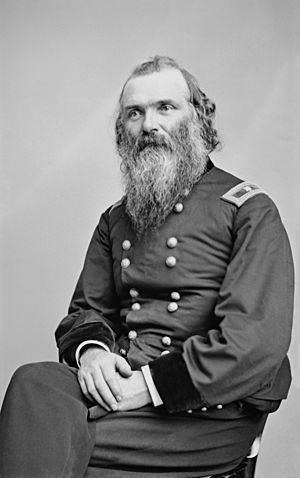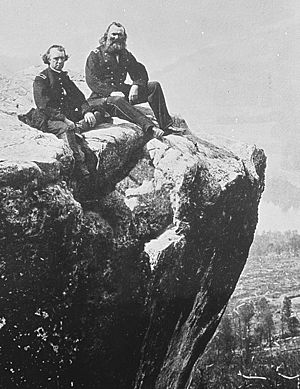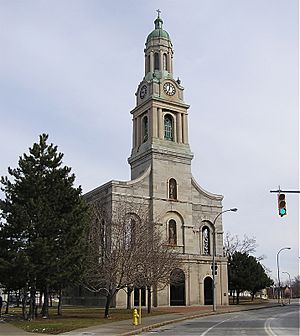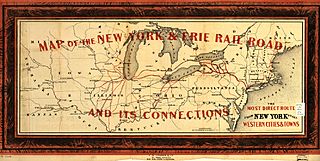Daniel McCallum facts for kids
Quick facts for kids
Daniel McCallum
|
|
|---|---|

Brig. Gen. McCallum
|
|
| Born | January 21, 1815 Johnstone, Scotland |
| Died | December 27, 1878 (aged 63) Brooklyn, New York |
| Place of burial |
Mount Hope Cemetery
|
| Allegiance | United States of America Union |
| Service/ |
United States Army Union Army |
| Years of service | 1861–1866 |
| Rank | |
| Commands held | U.S. Military Railroads |
| Battles/wars | American Civil War |
| Other work | railroad engineer, civil engineer, architect |
Daniel Craig McCallum (born January 21, 1815 – died December 27, 1878) was a smart Scottish-American engineer. He became a top manager for the New York and Erie Railroad. During the American Civil War, he was a Major General in charge of the United States Military Railroads.
McCallum is famous for being one of the first people to think deeply about how to manage large organizations. He created important rules for management. He also made the very first modern organizational chart, which shows how a company is structured.
Contents
Early Life and Moving to America
Daniel McCallum was born in Johnstone, Scotland, in 1815. When he was seven years old, his family moved to Rochester, New York, in America. Daniel went to elementary school, but he didn't want to be a tailor like his father. Instead, he left school to become a carpenter. He worked hard and learned many skills.
Building Bridges and Railroads
In the early 1840s, McCallum worked as a civil engineer in Rochester. He designed buildings, including Saint Joseph's Church. Soon, he started building and fixing railway bridges for the New York and Erie Railroad.
By the late 1840s, McCallum was in charge of all bridges for the New York and Erie Railroad. He started trying out new ways to build them. In 1851, he received a patent for his new bridge design. It was called the "McCallum Inflexible Arched Truss Bridge." This bridge could hold heavier loads and needed less repair than older designs. One of his bridges in Lanesboro, Pennsylvania, became very famous for being so strong.
In the early 1850s, McCallum was promoted to superintendent of one of the railroad's main sections. A few years later, in 1854, he became the railroad's General Superintendent. In this big role, he managed the entire railroad. He also reorganized it to make it run better and safer. He used new ways of managing and communicating, often using the telegraph. McCallum also wrote down his new management ideas and introduced the first modern organizational chart. In 1858, he left the Erie Railroad and started his own company, the McCallum Bridge Company.
Leading Military Railroads in the Civil War
On February 11, 1862, during the American Civil War, Daniel McCallum was given a very important job. The Secretary of War, Edwin M. Stanton, made him the military director and superintendent of the United States Military Railroad. He was given the rank of colonel.
The main job of the US Military Railroads was to fix and run captured Southern railway lines. This helped the Union army move soldiers, weapons, and supplies. McCallum stayed in Washington D.C. during the war. He managed the big picture of railroad operations. He made sure that trains, engines, and other equipment were delivered from factories.
McCallum was promoted to brigadier general in 1864 for his excellent work. His authority was then extended to help the Union army in the Western states, especially during General Sherman's important Atlanta Campaign. He was promoted again to major general in 1865. In July 1866, McCallum left the military. He then wrote a report about the military railroads during the war.
McCallum also wrote poems. His most famous poem, 'Lights on the Bridge,' was written shortly before he died. It remembered his friend, Sam Campbell, a railroad engineer who died in 1842. Daniel McCallum passed away in Brooklyn, New York, on December 27, 1878.
McCallum's Important Work
Designing Buildings and Bridges
From 1840, McCallum worked as an architect in Rochester. He was very good at his job. He designed several important buildings, including the House of Refuge, St. Joseph's Church, St. Mary's Hospital, and the Odd-Fellows' Hall. He helped make the city's buildings look better.
St. Joseph's Church was built between 1843 and 1846. It had a simple, grand style with a gray stone front. The church was made bigger in 1849. Today, only the front part of St. Joseph's Church remains.
The "Inflexible Arched Truss Bridge"
In the late 1840s, McCallum created a special type of truss bridge for railroads. It was called the "McCallum inflexible arched truss." These bridges were mostly made of strong pine wood, with fewer iron parts than other designs.
These strong bridges were used for wooden railroad bridges across the US and Canada in the 1800s. After working for the New York and Erie Railroad, McCallum started his own company, the McCallum Bridge Company, in 1858. His company built railroad bridges in the Western and Southern states. However, when steel bridges became popular in the 1860s, his unique wooden design became old-fashioned.
Solving Big Management Problems
McCallum started at the New York & Erie Railroad building bridges. He eventually became the general superintendent in 1855, managing over 5,000 employees. In this role, he saw the huge management problems that big railroad companies faced. These companies, like the Pennsylvania Railroad and the Baltimore and Ohio Railroad, found it expensive to move goods.
McCallum believed this was because their internal organization was not efficient. In his 1856 report, he explained that a small railroad could be managed easily. But a very long railroad needed a perfect system. He said that the secret to success for large railroads was a well-planned and strictly followed system.
New ways were needed to manage money, run a widespread system, and supervise thousands of workers. Railroads solved these problems and became a model for all large businesses. McCallum, along with other engineers, helped create the idea of different departments in a company. They also defined who was in charge of what, which are still important ideas in modern companies today.
The First Modern Organizational Chart
As general superintendent, McCallum designed an amazing chart in 1855. It showed how the New York and Erie Railway was organized. This chart is known as the first modern organization chart. A civil engineer named George Holt Henshaw drew it. The chart showed how many employees were in each department. It also showed who reported to whom.
The chart explained that the Board of Directors had the main power. This power flowed down to the President, who then controlled other officers. These officers, in turn, managed their teams, all the way down to the lowest employee. This system made sure that orders were given quickly and that everyone knew who their boss was.
For many years, people thought this chart was lost. But in 2005, researchers Charles D. Wrege and Guidon Sorbo Jr. found it at the Library of Congress. They thought the idea for the chart's tree-like shape might have come from a local flower called the pussy willow.
McCallum's Management Rules
As General Superintendent, McCallum developed new ideas for a modern management system. In his 1856 report, he listed important rules for a successful system:
- First, clearly divide who is responsible for what.
- Second, give people enough power to do their jobs well.
- Third, have ways to know if people are doing their jobs correctly.
- Fourth, quickly report any mistakes so they can be fixed right away.
- Fifth, use daily reports and checks that help managers, not confuse them.
- Sixth, have a system that helps the general superintendent find errors and the person responsible.
McCallum also believed that employees should only report to their direct boss. Each manager should be able to hire and fire people they are responsible for, with the approval of the general superintendent.
Leading Railroads in the Civil War

When McCallum became the military director of Union railroads in 1862, he had a lot of power. He could take over any railroad, train, or equipment needed for the war. His goal was to make the military railroads a "great construction and transportation machine" to help the generals. He was known for being a strict leader, but he combined his engineering skills with a good personality to succeed.
McCallum's assistant was Herman Haupt, another talented engineer. McCallum managed the overall administration of the US Military Railroads. Haupt was in charge of running the railroads in the field. When McCallum started, the government only controlled a short railroad line. By the end of the war, the US Military Railroads had used parts of 17 railroads in the East and 23 in the West. The Construction Corps, which built and repaired lines, grew from about 300 men to nearly 10,000 men.
McCallum's biggest success was supporting General Sherman's army in 1864. He successfully supplied 100,000 soldiers and 60,000 animals during Sherman's campaign from Chattanooga to Atlanta. This was a huge achievement for the military railroads.
In 1865, McCallum helped organize the Funeral and burial of Abraham Lincoln. After President Abraham Lincoln was assassinated, his body was taken by a special funeral train from Washington, D.C., to his hometown in Springfield, Illinois. The War Department put McCallum in charge of the railroads used for this journey. No one was allowed on the train except those approved by the War Department. The train traveled slowly, no more than 20 miles per hour, to prevent any accidents.
McCallum's hard work made the railroad service very efficient during the Civil War. He was honored with the rank of brigadier general and then major general. He left the military on July 31, 1866. That same year, he published a report about his work with the military railroads during the war.
Images for kids
See also
 In Spanish: Daniel Mc Callum para niños
In Spanish: Daniel Mc Callum para niños







